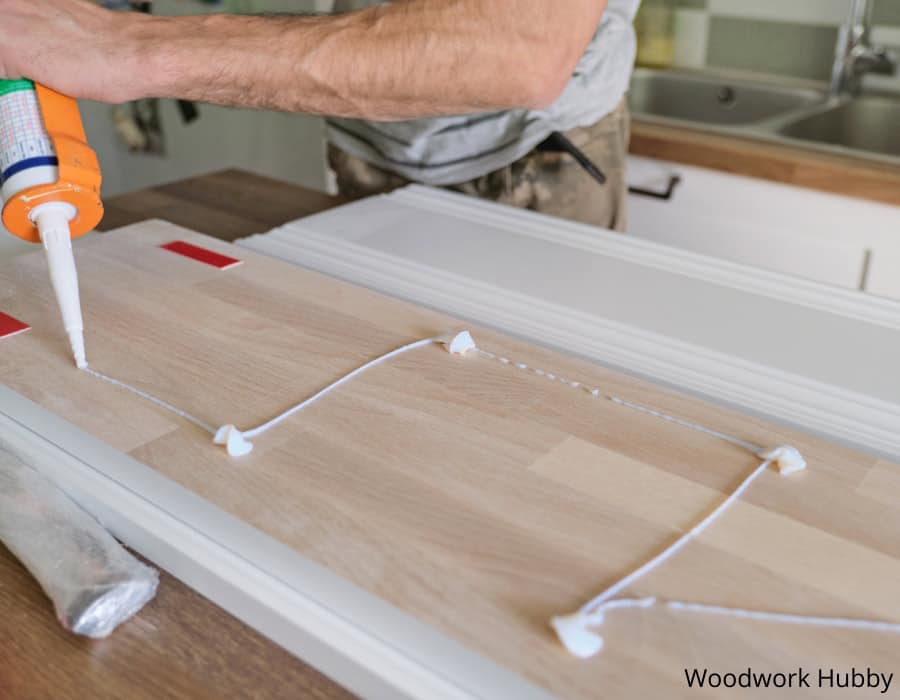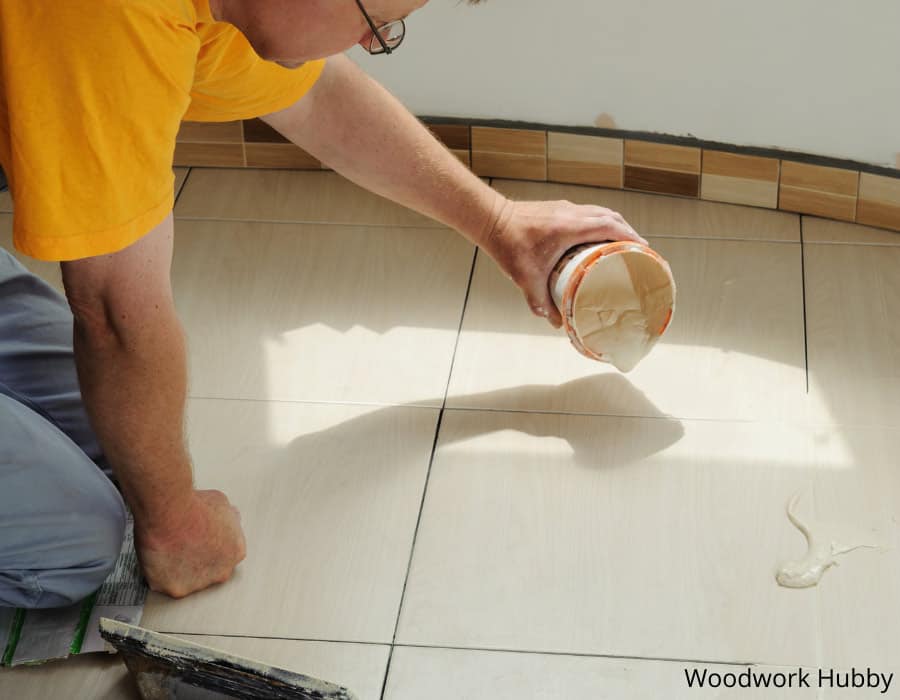After successfully making your wooden shelf or even wanting to change the look of your floor, will often involve you needing to glue wood to tile. Will that be strong enough? This brings forward the question…Can you glue wood to tile?
Wood can be glued to tiles using a good quality multipurpose adhesive. It is recommended that the tile surface be roughened up with sandpaper to ensure a good glue bond.
The condition of your tile flooring, as well as what materials it is made from, and your choice of adhesive will determine how well the finished product holds up. Multi-purpose glue that is designed to be used with wood and tile works best.
This is my favorite glue to use.
You want to make sure you are using glue that is designed for the type of tile in your home and is also meant to be used with the wood you have chosen. There are steps you need to take to prepare the floor for the installation. I will go over all of that and more in the sections below.
Adding Wood over Tiled Flooring or Trim
Most people asking, “can you glue wood to tile?” want to create a new look in their home. Wood can breathe new life into decorative trim or cover old floor designs. If you recently purchased the house or do not know the building history, you need to identify the type of tiling you are going to be covering up.
There are a few tips for doing this quickly, but your best bet is to get ahold of someone with information on the building’s design who can give you accurate information. The majority of my examples in this article will involve flooring because that is most common, but these same materials will work the same for moldings.
Common Tile Materials
Before you can get started with your installation, you need to know what materials you are working with. Some tiles like ceramic need specialized glue to adhere properly. Below are the most common materials used for creating floor, wall, or decorative tiling.
- Ceramic
- Concrete
- Glass
- Granite
- Limestone
- Mosaic
- Marbles
- Metal
- Resin
How to Determine What Type of Tile You Have
If you believe your flooring might be made from a type of stone tile, then drop a bit of water on it, and it should absorb some of the moisture. You can also look closely at the edges and corners. Machine marks are usually a sign that it is a natural stone material that was cut.
Manufactured material is generally very smooth and clean-cut along the edges. Here are a few details you might notice that could indicate what type of tile you have in your home.
- Ceramic: Smooth and non-textured.
- Granite: Polished stone that resembles marble but featuring dark spots instead of veins.
- Limestone: It has a glossy surface that resembles marble without the distinctive veins.
- Mosaic: Glazed with an artificial color pattern. They can be made of multiple materials, including glass and ceramic.
- Marbles: A unique non-repeating vein pattern within the tile sets it apart from other similar materials.
- Resin: It is challenging to differentiate resin from natural materials because it can so accurately duplicate textures. However, they are prone to chipping and, if subjected to regular natural light, might have a yellow tint.

Wood can be glued to most household tiles.
Prepare Your Floor Before Gluing the Wood
Once you have identified your flooring tiles and found a glue that will work, there are still a few crucial steps that you need to take to prepare the floor. You cannot glue new flooring over older tiles that are loose, too smooth to properly adhere, or surrounded by deep grout lines. Here are some ways you can make sure your tile is ready.
Check out my article on Titebond 3 Wood glue to see if it’s better than Titebond 2.
Look for Loose Tiles
The most frequent issues that you will come across are loose or cracked tiles. Loose tiles are prevalent in older floors or areas that get a lot of foot traffic. If you try to glue some wood over any flooring with these issues, your installation will not work correctly. You must first repair and secure the underlying tile before you can glue the new wood.
Here are steps you can take to fix loose, damaged, or ill-fitting tiles.
- Heat the tile with an iron. This will loosen the adhesive under the tile and make it easier to thoroughly remove the tile without risking damage.
- Use a putty knife or some similar tool to gently pry up the tile from the center of each side, working towards the corners. Be careful and remove the tile once it is completely loose.
- Dissolve the remaining adhesive. You can do this using mineral spirits or a product from your local hardware store.
- Apply new adhesive. Put a new tile in place and make sure it is placed well and then weighed down until completely dried.
- Redo grout around the new tile. You can now install the wood over it.
Rough Up Smooth Surfaces
Some tiles like ceramic are going to have a surface that is too smooth thanks to the glazing. The polished finish will make it harder for the glue to adhere. You will need to rough it up a little with sandpaper to make sure that the glue has a way to grip the tiles.
The use of coarse 80 grit sandpaper will work the best. The tiles will be quite abrasive and will dull your sandpaper quickly. Larger areas may require the use of multiple pieces of sandpaper. Hand sanding is fine here. No need to use an electric sander unless you have extremely large areas to do.
Check Floor Height
You want to make sure that adding wood over the tile is not going to interfere with things like doors or fixtures. When replacing tiled flooring, you will be raising the floor. It is essential to measure everything out carefully to make sure that your installation is not going to interfere with the functionality of doors, baseboards, or appliances that might require that extra few inches.
Tile that is bordered with carpet can also be tricky because the new floor will be higher than the carpet. You can add a shim to make the change more gradual.
Make Sure the Floor is Flat
Many floors feature a slight tilt due to either movement of the foundation or some other structural issue. There can also be several high or low points caused by uneven tile. You will want to make sure your floor is flat and even.
If you find that some areas of tile are lower, you can use a self-leveling compound. These compounds are available at your local hardware store. You can also grind down the tile if you find a few small spots that are too high.
ReFill Very Deep Grout Joints

Some types of flooring have unusually deep or wide grout joints that need to be filled to ensure an even surface area. You can use grout filler. You will want to remove the majority of the original grout and then fill everything in with a new mixture. A benefit of putting in the new filler is that it will remove any loose grout and make the line sturdier.
Which Glue to Use on Your Tiles
Water-based formulas work well when you are looking for a glue that will adhere best to wood. There are plenty of these that are also designed to work with tile and other materials. Check the glue before using it to make sure that it is going to work on not only your tile and wood but also any leveling compound or other materials you used to get the tile flooring flat and even.
Multi-purpose floor adhesives have the most versatility. Below are some of the products I have used and can recommend, but it is difficult to give a definite glue since it will depend on what materials you are using.
Dap 00141 Multi-Purpose Floor Adhesive
- This multi-purpose should only be used for gluing plywood and other composite woods to tile.
- There is a long wait time for complete drying, which gives you plenty of time to move things around as needed.
ROBERTS 7350-1 Flooring Adhesive
- Plywood can be glued down using this over vinyl, steel, marble, and terrazzo tiling.
- It has moisture control and creates a water-proof, permanent seal.
Glues You Should Avoid
Can you glue wood to tile? Yes, but not with all of the adhesives on the market. You need to make sure that whatever glue you buy is going to work for both the wood and the type of tile you have in your home.
Always read the manufacturer guidelines carefully before purchasing a product so that you can be confident it can keep your wood firmly glued to the tile. You should avoid using glues that are not explicitly designed to be used on the materials you are using.
What to Look For When Buying Glue
You will want to check a few things before purchasing glue for your project. Knowing these details can help you plan better. When you are shopping for glue online or in-person at your local hardware store, look for the following information.
- Drying Time: This will impact how long you have to get everything set up before the glue begins to dry and can affect the way in which you choose to put down the wood.
- “Recommended Use”: You will want to make sure that it is meant to be used on the materials that you are using. This information is usually listed under the “recommended use” section on the packaging.
- Area Coverage: There should be an estimated square foot covering for the adhesive, so you know how much you will need to buy to cover the entire tile.
- Indoor or Outdoor Use: If your project is taking place indoors, make sure that it is designed to be used indoors. Sometimes there are products with toxic ingredients that make them too dangerous to use indoors.
Conclusion – Can You Glue Wood To Tile?
Wood can be glued to tiles provided you take the time to do good surface prep such as scuffing up the tile surface and you use a good quality glue.
Do you want some more helpful woodworking tips? Be sure to check out more of my articles at woodwork hubby.



